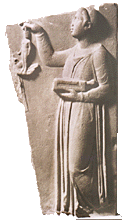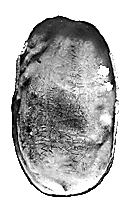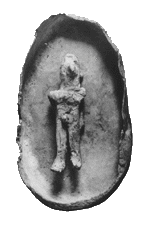

In Classical Athens, the gifts that accompanied the corpse were placed in ditches, or in specific places in the pit-grave's coverlet of earth, or around the corpse. The class of grave-offerings of which we have most examples are clay pots (e.g. kylix, lekanis, ribbon-handled banded plate [pinakion], white-ground lekythos, lebes gamikos, hydria, and chytra). These pots are black-glazed either with or without impressed motifs, undecorated, sometimes without red-figures and sometimes even unslipped. Two types of pot that were specially associated with child burials were the chous (a small trefoil-lipped oinochoe) and the thelastron.
|
A second class of grave-offerings were stone vessels of marble or alabaster: (pyxis with lid, plemochoe, and alabastron). Some, such as the alabaster vessels known as pseudo-alabastra, were made in one solid piece, and this is an indication that they were used only for burials. Favourite objects, as well as pots, could be grave-offerings to the dead. Some objects of this sort found in the graves of Classical Athens were toys, strigils, and mirrors. A small amount of jewelry has been found in Classical Athenian tombs - mostly bronze and gold rings and earrings. Clay statuettes have also been found in a number of tombs, and show figures of a familiar and popular kind: seated female figures, busts, animals, toys, and plangones. |
 |
 |
 |
We cannot be certain what some of the finds in Classical Athenian graves were meant for. For example, there are miniature arms (to the elbow) ten centimetres long; the arm being outstretched and the fingers closed. Often the arm is supported on a flat base. They were quite possibly involved some kind of white magic. In some of the graves we find curse tablets and miniature lead coffins. |
 |
 |
|
| |
|||
| |||